The events described here actually took place on July 15th.
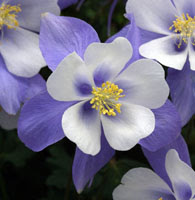
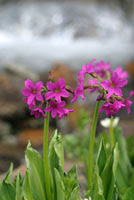
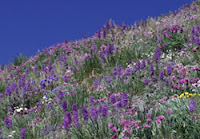 Today we started from Silverton, headed for Animus Forks, but just short of Animus Forks we turned left on a steep road up Picayune Gulch. We then went down Placer Gulch to Animus Forks, up to Cinnamon Pass (as we knew the high meadows there were in bloom), and then back to Animus Forks and down to Silverton. The Picayune Gulch road proved to be unexpectedly pretty, with the road winding through an almost riparian landscape of spruce and fir sparsely scattered in steep meadows. Also there were wonderful views down to the valleys below, and to the surrounding peaks. At the top of Picayune Gulch, a small peak (which is also at the top of Placer Gulch) had several knobs that were covered with an array of flowers. The left-most photo at right is a typical example. For some reason, the dominant colors in this area were blues and lavendars. We don't know what any of these flowers are. My dad and I made a tough (though mercifully short) climb up an awesomely steep hillside to get to the top of this knob. The high altitude (12,000 feet+) makes getting adequate oxygen a challenge. Hard, heavy breathing is the only answer. The center photo at right is of one of the jewels of the wet places at high altitudes: a Parry's Primrose. The color of these blooms is quite startling in the settings where it is typically found. This plant was growing right at the edge of an ice-cold stream, the result of a melting snowbank a few feet away. The right-most photo is of an unusually deep blue columbine, which is one of our favorite wildflowers. The lighter and more lavendar variant is far more common than this blue.
Today we started from Silverton, headed for Animus Forks, but just short of Animus Forks we turned left on a steep road up Picayune Gulch. We then went down Placer Gulch to Animus Forks, up to Cinnamon Pass (as we knew the high meadows there were in bloom), and then back to Animus Forks and down to Silverton. The Picayune Gulch road proved to be unexpectedly pretty, with the road winding through an almost riparian landscape of spruce and fir sparsely scattered in steep meadows. Also there were wonderful views down to the valleys below, and to the surrounding peaks. At the top of Picayune Gulch, a small peak (which is also at the top of Placer Gulch) had several knobs that were covered with an array of flowers. The left-most photo at right is a typical example. For some reason, the dominant colors in this area were blues and lavendars. We don't know what any of these flowers are. My dad and I made a tough (though mercifully short) climb up an awesomely steep hillside to get to the top of this knob. The high altitude (12,000 feet+) makes getting adequate oxygen a challenge. Hard, heavy breathing is the only answer. The center photo at right is of one of the jewels of the wet places at high altitudes: a Parry's Primrose. The color of these blooms is quite startling in the settings where it is typically found. This plant was growing right at the edge of an ice-cold stream, the result of a melting snowbank a few feet away. The right-most photo is of an unusually deep blue columbine, which is one of our favorite wildflowers. The lighter and more lavendar variant is far more common than this blue.
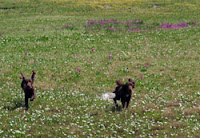
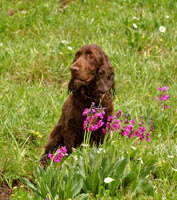
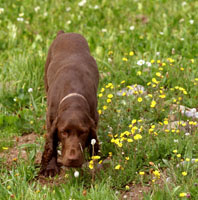 Our dogs once again had a wonderful time romping through the meadows. The left-most photo at right is Mo'i, the great hunter of pika and other rodentia. He actually managed to catch a pika today, very briefly — the poor little pika was actually in his mouth, but somehow got away. We saw it a moment later, scurrying along a stream bank, running for its life. We imagined that it is now telling tales to its friends, about the brown monster with gigantic teeth that almost ate it. Mo'i loves to smell out a rodent's hole and then shove his snout in as far as he can get it, inhaling deeply of rodent odor. The ecstatic look on his face at such moments is something to behold. The center photo is Lea during a sit-stay, being good. In front of her is a nice patch of slightly past prime Parry's Primrose (this particular meadow was very wet, which didn't bother the dogs one whit). The photo at right is both dogs bounding across the meadow toward me, as I attempt to change the focus of my lens as fast as they're approaching me. Tough. You can see a nice patch of Parry's Primrose in the upper right. This set of romps was their last before heading off (with Debi) to the "C-SPOT-WIN" training camp. There both the dogs and Debi will be working very hard to learn how to compete more successfully in agility trials.
Our dogs once again had a wonderful time romping through the meadows. The left-most photo at right is Mo'i, the great hunter of pika and other rodentia. He actually managed to catch a pika today, very briefly — the poor little pika was actually in his mouth, but somehow got away. We saw it a moment later, scurrying along a stream bank, running for its life. We imagined that it is now telling tales to its friends, about the brown monster with gigantic teeth that almost ate it. Mo'i loves to smell out a rodent's hole and then shove his snout in as far as he can get it, inhaling deeply of rodent odor. The ecstatic look on his face at such moments is something to behold. The center photo is Lea during a sit-stay, being good. In front of her is a nice patch of slightly past prime Parry's Primrose (this particular meadow was very wet, which didn't bother the dogs one whit). The photo at right is both dogs bounding across the meadow toward me, as I attempt to change the focus of my lens as fast as they're approaching me. Tough. You can see a nice patch of Parry's Primrose in the upper right. This set of romps was their last before heading off (with Debi) to the "C-SPOT-WIN" training camp. There both the dogs and Debi will be working very hard to learn how to compete more successfully in agility trials.
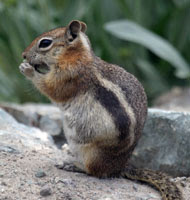
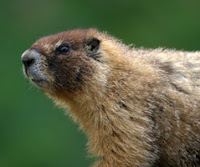 Finally, there's a little wildlife. Most of you will know that the beastie in the right-most photo is a chipmunk. These are very common up here, and they seem to come in a whole range of sizes, from large mouse-sized to small squirrel-sized. This fellow was a "medium" on that scale. The rodents here seem to be much less shy than the ones we have at home, and we theorize that this is because of a (to us) mysterious lack of predators. We haven't seen a single hawk during our travels, nor any four-footed predator. We have no idea why this is so, as the rodents are very numerous. The left-most photo is of a large rodent that you may not be familiar with: a marmot. These are also very common, and nearly fearless. Marmots are fairly large rodents, about the size of a very large and fat housecat. I took this photo with a 450mm stabilized telephoto from our LandCruiser's window; the marmot was perhaps 30 feet away.
Finally, there's a little wildlife. Most of you will know that the beastie in the right-most photo is a chipmunk. These are very common up here, and they seem to come in a whole range of sizes, from large mouse-sized to small squirrel-sized. This fellow was a "medium" on that scale. The rodents here seem to be much less shy than the ones we have at home, and we theorize that this is because of a (to us) mysterious lack of predators. We haven't seen a single hawk during our travels, nor any four-footed predator. We have no idea why this is so, as the rodents are very numerous. The left-most photo is of a large rodent that you may not be familiar with: a marmot. These are also very common, and nearly fearless. Marmots are fairly large rodents, about the size of a very large and fat housecat. I took this photo with a 450mm stabilized telephoto from our LandCruiser's window; the marmot was perhaps 30 feet away.
As usual, click on any photo for a larger view.
